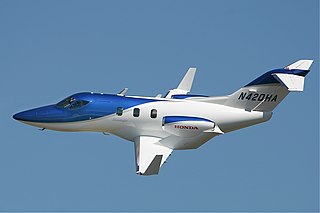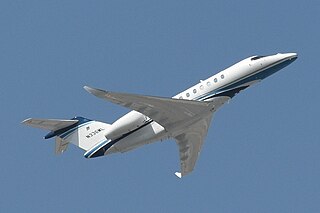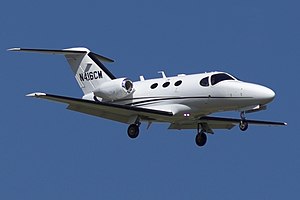
The Cessna 750 Citation X is an American mid-size business jet produced by Cessna; it is part of the Citation family. Announced at the October 1990 NBAA convention, the Model 750 made its maiden flight on December 21, 1993, received its type certification on June 3, 1996, and was first delivered in July 1996. The updated Citation X+ was offered from 2012 with a 14 in (360 mm) cabin stretch and upgraded systems. Keeping the Citation III fuselage cross section, it has a new 37° swept wing with an area of 527 ft² for a fast Mach 0.935 MMO and a 36,600 lb MTOW for a 3,460 nmi (6,408 km) range, a T-tail and two 7,034 lbf (31.29 kN) AE3007 turbofans. After 338 deliveries, production ended in 2018.

The Learjet 60 is a mid-size cabin, medium-range business jet aircraft manufactured by Bombardier Aerospace in Wichita, Kansas. Powered by two Pratt & Whitney Canada PW305A engines, it has a range of 2,405 nautical miles (4,454 km) with NBAA 100 nmi (190 km) reserves, ISA. In July 2012 Bombardier Aerospace announced a temporary "production pause" of the latest variant Learjet 60XR to begin in the fourth quarter of 2012.

The Embraer EMB-500 Phenom 100 is a very light (VLJ) business jet designed and produced by the Brazilian aircraft manufacturer Embraer. Announced in November 2005, it made its first flight on 26 July 2007 and was awarded a type certificate in December 2008; the first aircraft was delivered the same month. The Phenom 100 has been stretched into the larger Embraer Phenom 300. Powered by two rear-mounted Pratt & Whitney Canada PW600 turbofans, it can transport four to seven passengers, with a range of 1,178 nautical miles [nmi] with four occupants. As of April 2023, 401 had been delivered.

The Honda HA-420 HondaJet is a light business jet produced by the Honda Aircraft Company of Greensboro, North Carolina, United States. Original concepts of the aircraft started in 1997 and were completed in 1999. It took its maiden flight on December 3, 2003, received its FAA type certificate in December 2015, and was first delivered that same month. As of February, 2024, 250 jets had been delivered.

The Hawker 400 is a light business jet. Initially designed and built by Mitsubishi, it has been further developed and updated by the Beech Aircraft Company, now part of Textron Aviation. A military version, the T-1 Jayhawk was also produced. In total, over 900 Hawker 400s have been delivered. In 2017, Hawker began to offer a manufacturer supported upgrade package known as the Hawker 400XPR. The new modifications are intended to reduce fuel consumption and improve range.

The Cessna Citation is a family of business jets manufactured by Cessna that entered service in 1972. In the fifty years following the type's first flight in 1969, more than 7,500 Citations were delivered, forming the largest business jet fleet in the world. Deliveries reached 8,000 by 2022, while logging over 41 million flight hours.

The Beechcraft Premier I is a light business jet aircraft manufactured by the Beechcraft division of Hawker Beechcraft. The aircraft was designed to compete with the Cessna CitationJet series of aircraft.

The Cessna Citation Excel is an American midsize business jet in the Cessna Citation family. Announced in October 1994, the Model 560XL first flew on February 29, 1996, certification was granted in April 1998, and over 1,000 have been delivered. The 2,100 nmi-range (3,900 km), 20,200 lb MTOW jet is powered by two 3,650–4,080 lbf (16.2–18.1 kN) PW545 turbofans, has the cruciform tail and unswept supercritical wing of the Citation V (560), and a slightly shortened Citation X stand-up cabin. The XLS 2004 update had upgraded engines and a glass cockpit and the 2008 XLS+ had upgraded engines and a revised nose.

The Cessna Citation III is an American business jet produced by Cessna and part of the Citation family. Announced at the October 1976 NBAA convention, the Model 650 made its maiden flight on May 30, 1979, received its type certification on April 30, 1982 and was delivered between 1983 and 1992. The cheaper Citation VI was produced from 1991 to 1995 and the more powerful Citation VII was offered between 1992 and 2000; 360 of all variants were delivered, while a proposed transcontinental variant, the Citation IV, was canceled before reaching the prototype stage. An all new design, the Citation III had a 312 sq ft swept wing for a 22,000 lb MTOW and a 2,350 nmi (4,350 km) range, a T-tail and two 3,650–4,080 lbf (16.2–18.1 kN) TFE731 turbofans. Its fuselage cross section and cockpit were kept in the later Citation X, Citation Excel and Citation Sovereign.

The Cessna CitationJet/CJ/M2 are a series of light business jets built by Cessna, and are part of the Citation family. Launched in October 1989, the first flight of the Model 525 was on April 29, 1991. Federal Aviation Administration (FAA) certification was awarded on October 16, 1992, and the first aircraft was delivered on March 30, 1993. The CJ series are powered by two Williams FJ44 engines; the design uses the Citation II's forward fuselage with a new carry-through section wing and a T-tail. The original CitationJet model has been updated into the CJ1/CJ1+/M2 variants; additionally, the CJ1 was stretched into the CJ2/CJ2+ which was built between 2000 and 2016. The design was then further developed into the CJ3/CJ3+, built from December 2004 to present, and finally into the CJ4 which has been built since 2010. By June 2017, 2,000 of all variants had been delivered.

The Embraer Legacy 450/500 and Praetor 500/600 are a family of mid-size and super mid-size business jets built by Brazilian aircraft manufacturer Embraer. The aircraft family was launched with the Legacy 500 in April 2008 and were the first jets in the size category to feature a flat-floor stand-up cabin and fly-by-wire.

The Cessna Citation Columbus was a business jet project by Cessna, part of the Cessna Citation family. The Model 850 was launched in February 2008 and cancelled in July 2009. It would have been the largest model of the family at the time. Powered by 8,830 lbf (39.3 kN) PW810 turbofans and a 4,000 nmi (7,400 km) range, the $27 million aircraft had a 709 sq ft, 30° swept wing.

The Cessna Citation V is a business jet built by Cessna that was in production from 1989 until 2011. During that time, 774 such craft were made. The first Model 560 prototype, a stretched version of the Citation S/II, flew in August 1987 and was certified on December 9, 1988.

The Cessna Citation Sovereign is an American business jet developed by Cessna, part of the Cessna Citation family. Announced at the 1998 NBAA convention, the Model 680 made its maiden flight in February 2002, certification was awarded on June 2, 2004, and deliveries began in late September. The Citation Excel fuselage was stretched and joined with an all-new, larger wing and more powerful Pratt & Whitney Canada PW306C engines for increased maximum takeoff weight and a 3,200 nmi (5,900 km) range. The improved Sovereign+ was announced at the October 2012 NBAA for a first flight in April 2013 and deliveries in December, with added winglets and an improved flight deck and engines.

The Eclipse 550 is a very light jet initially built by Eclipse Aerospace and later One Aviation of Albuquerque, New Mexico, United States. The aircraft is a development version of the Eclipse 500, which was produced by predecessor Eclipse Aviation. Like the 500, the 550 is a low-wing, six seat, twin engine jet-powered aircraft. The Eclipse 550 is certified for single-pilot operation.

The Cessna Citation Longitude is a business jet produced by Cessna, part of the Cessna Citation family. It remains the largest business jet by Cessna. Announced at the May 2012 EBACE, the Model 700 made its first flight on October 8, 2016, with certification obtained in September 2019. The aluminum airframe has the fuselage cross-section of the Citation Latitude, stretched by a seat row. Powered by Honeywell HTF7000 turbofans, it has a new ~28° swept wing and a T-tail for a 3,500 nmi (6,500 km) range.

The Cessna Citation Latitude is a business jet built by Cessna. The Model 680A was announced at the 2011 NBAA convention, the prototype first flew on 18 February 2014, it achieved FAA certification on June 5, 2015, and first deliveries began on August 27. It retains the Model 680 Sovereign wing, twin P&WC PW306D turbofans and cruciform tail and adds a new stand-up circular fuselage with a flat floor, which was kept in the stretched, re-winged, and re-engined Cessna Citation Longitude.

The Pilatus PC-24 is a light business jet produced by Pilatus Aircraft of Switzerland. Following the success of the PC-12 single engine turboprop, work on the twin engine jet began in 2007 for greater range and speed, keeping the rough-field capability. The aircraft was introduced on 21 May 2013 and rolled out on 1 August 2014, with the maiden flight on 11 May 2015. The PC-24 received EASA and FAA type certification on 7 December 2017 and the first customer delivery was on 7 February 2018. Powered by two Williams FJ44 turbofans, it competes with the Embraer Phenom 300 and the Cessna Citation CJ4.

The Beechcraft Denali, also known as the Model 220 and previously the Cessna Denali and Textron "Single Engine Turboprop" (SETP), is an American single engine turboprop aircraft under development by Textron Aviation. Announced at EAA AirVenture Oshkosh 2015, the aircraft is a completely new design, not derived from any existing aircraft. It should compete primarily with the nine-passenger Pilatus PC-12 as well as slightly faster and smaller single-engine turboprops such as the Epic E1000, Piper M700 Fury, and SOCATA TBM.
The Stratos 714 is an American very light jet aircraft under development by Stratos Aircraft of Redmond, Oregon. The project was announced in July 2008, a prototype first flew on 21 November 2016, although Stratos currently lacks the funding to complete type certification. Predominantly made of carbon composite, the single turbofan aircraft would seat four to six at 400 kn (740 km/h) over up to 1,500 nmi (2,800 km).























